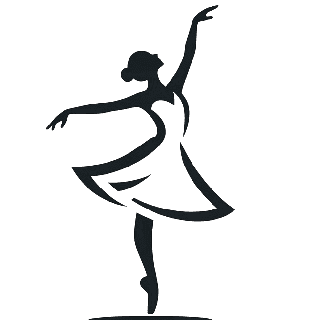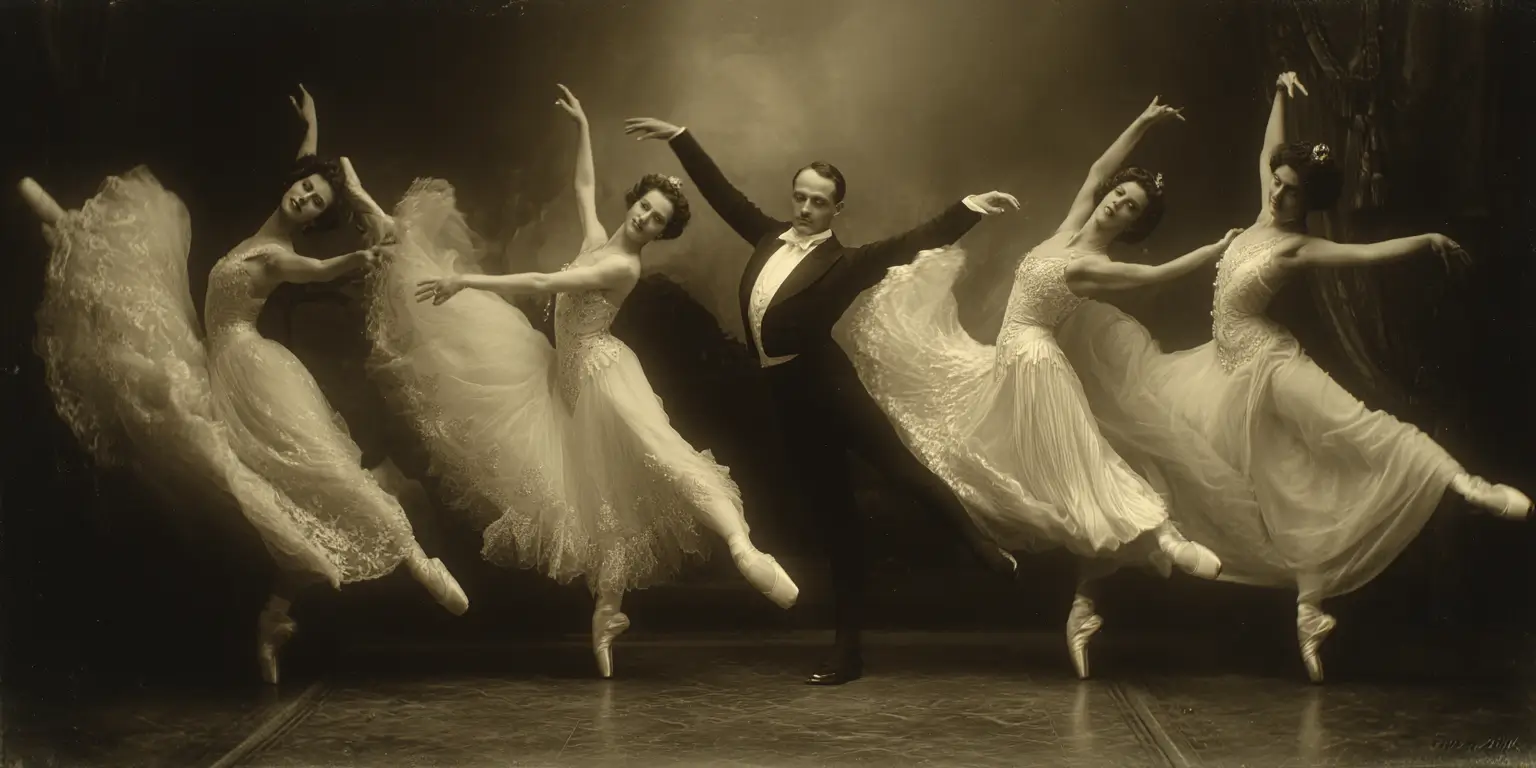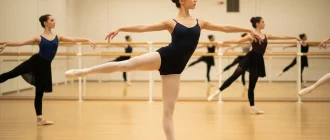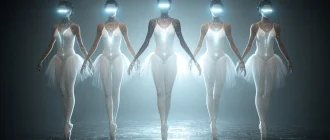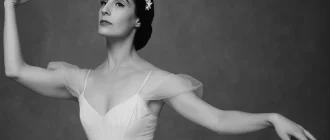Ballet in the Romantic era, spanning the early to mid-19th century, introduced emotion, dramatic storytelling, and supernatural themes to dance. This period brought iconic works like ‘Giselle’ and ‘La Sylphide’ and influential dancers such as Marie Taglioni.
This article explores these transformations and their lasting impact on ballet. A significant feature of this era was the emergence of ‘ballet blanc,’ which emphasized ethereal and otherworldly qualities in performances.
Key Takeaways
- Romantic ballet emerged in the early 19th century, characterized by emotional storytelling, supernatural themes, and an emphasis on the ethereal nature of its performances.
- Key figures, such as Marie Taglioni and Fanny Elssler, transformed the role of female dancers, setting new technical and artistic benchmarks while popularizing the use of pointe work and the romantic tutu.
- The legacy of Romantic ballet continues to influence contemporary works through its dramatic narratives, innovative choreography, and the integration of original music, inspiring a generation of dancers and choreographers.
- The ‘ballet blanc’ tradition, featuring white costumes and a focus on the purity and lightness of the dancers, played a crucial role in defining the aesthetic and thematic elements of Romantic ballet.
| Category | Details |
|---|---|
| Period | 1820s–1870s |
| Key Themes | Love, betrayal, supernatural elements (e.g., sylphs, ghosts, fairies), emotion, mysticism, and ethereal beauty |
| Iconic Works | La Sylphide (1832, Filippo Taglioni), Giselle (1841, Jean Coralli and Jules Perrot), Pas de Quatre (1845, Jules Perrot) |
| Prominent Ballerinas | Marie Taglioni (La Sylphide), Fanny Elssler (dramatic character dances), Carlotta Grisi (Giselle), Lucile Grahn, Fanny Cerrito |
| Technical Innovations | Development of pointe work (creating a weightless, ethereal effect), gas lighting for atmospheric stage effects |
| Costume Innovations | Romantic tutu: calf-length, bell-shaped, soft fabrics symbolizing ethereal quality |
| Key Locations | Paris Opera Ballet (France), La Scala (Italy), Mariinsky Theatre (Russia), Her Majesty’s Theatre (London) |
| Music Contributions | Integrated classical compositions by Adolphe Adam (Giselle) and Léo Delibes (La Source), with atmospheric scores complementing the themes |
| Cultural Impact | Mirrored societal fascination with mysticism and the supernatural; influenced literature and art; set groundwork for Classical ballet’s grand narratives |
| Signature Style | Lightness, fluidity, expressive storytelling, emphasis on emotion, and ethereal portrayals |
| Notable Choreographers | Filippo Taglioni (La Sylphide), Jean Coralli and Jules Perrot (Giselle), Jules Perrot (Pas de Quatre) |
| Decline of the Era | Romantic ballet faded in the late 19th century as classical ballet, focusing on grand storytelling and technical virtuosity, rose under Marius Petipa’s influence. |
The Essence of Romantic Ballet

Romantic ballet is a genre that thrives on emotion and dramatic storytelling. From the early 19th to the 19th century, ballet evolved into a medium that expressed the deepest human emotions and explored themes of love, loss, and the supernatural.
The Romantic era was characterized by a fascination with fantasy and the ethereal, introducing elements such as fairy maidens and ghostly figures into its narratives. Giselle, one of the quintessential Romantic ballets, delves into themes of madness and betrayal, blending love with supernatural folklore.
A broader societal shift towards urbanization influenced the Romantic Movement in ballet. Artists and audiences longed for themes of nature and escapism, seeking solace in the fantastical and the otherworldly. Ballet blanc, a term used to describe scenes featuring dancers in white tutus, became a hallmark of Romantic ballet, emphasizing the ethereal and supernatural themes.
This era marked a significant transition in the ballet audience, with middle-class viewers replacing the aristocratic patrons of the past. This change brought a new relatability and emotional connection to ballet performances, resonating deeply with the general public.
Iconic works such as La Sylphide and Giselle exemplify the essence of Romantic ballet. La Sylphide tells the story of an artist’s quest for an unattainable ideal, embodying the Romantic era’s preoccupation with the supernatural and the ethereal. These famous ballets not only captivated audiences with their dramatic narratives but also showcased the heightened technical skills of their performers, setting new standards in ballet technique.
The themes prevalent in Romantic ballets, including the conflict between good and evil and the exploration of the supernatural, continue to influence the art form today. This period’s emotional depth and dramatic storytelling have left a lasting legacy, shaping the trajectory of ballet and inspiring countless works that followed.
The Artistic Elements of Romantic Ballet
The Romantic ballet was a tapestry of artistic elements that distinguished it from other ballet forms. At its core was a profound emphasis on dramatic storytelling, often drawing inspiration from literature and folklore. These ballets were renowned for their intricate plots, weaving tales set in fantastical or supernatural realms that captivated audiences with their complexity and emotional depth.
Music was pivotal in Romantic ballet, marking a departure from adapting existing scores to creating original compositions. Composers like Adolphe Adam crafted innovative scores specifically for ballets, enhancing the narrative and emotional resonance of the performances. This era saw the birth of music that was not just an accompaniment but an integral part of the storytelling.
Costumes and sets in Romantic ballet were designed to create a sense of drama and spectacle. Elaborate and ornate costumes, particularly the romantic tutu made of layered tulle, became iconic.
Combined with atmospheric sets, lighting, and special effects, these costumes transported audiences into magical worlds. The “white act” of many ballets, where dancers donned ethereal white tutus, epitomized the era’s fascination with the supernatural and the otherworldly.
The Romantic era also heralded the rise of the romantic ballerina, celebrated for her technical prowess and expressive artistry. Female dancers like Marie Taglioni became the stars of the ballet world, their performances characterized by a delicate, ethereal quality. Pointe work, which allowed dancers to perform on the tips of their toes, became a defining feature of the era’s signature move, enhancing the illusion of weightlessness and grace.
In contrast, the role of the male dancer diminished during this period. While male dancers were still present, many male roles were performed by female dancers in travesty, and the focus shifted towards the female lead. However, male dancers continued to contribute to the drama and tension of the performances, albeit in a more supportive capacity.
Overall, the artistic elements of Romantic ballet were a blend of dramatic storytelling, innovative music, elaborate costumes, and atmospheric sets. The era’s focus on the female dancer and the development of pointe work left a lasting legacy, shaping the future of ballet as an art form.
Key Figures in Romantic Ballet
In Romantic ballet, few figures are as influential as Marie Taglioni. Celebrated for her ethereal qualities and lyrical movement style, Taglioni became the quintessential Romantic ballerina. Her performance in La Sylphide, choreographed by her father in 1832, marked a defining moment in ballet history.
Taglioni’s ability to embody her roles’ supernatural and otherworldly aspects made her a cultural icon, even inspiring products named after her, such as Taglioni caramels in Russia. Her performances in ‘ballet blanc’ scenes further solidified her legacy, showcasing her ethereal presence and technical prowess.
Fanny Elssler, another prominent figure of this era, was known for her fiery and exotic style. Her performance of the cachucha, a spirited Spanish dance, showcased her unique attributes and ensured her place in ballet history.
The rivalry that danced between Taglioni and Elssler highlighted their contrasting styles, with Taglioni representing spirituality and etherealism, while Elssler embodied sensuality and passion. Elssler’s international tours, including a notable trip to North America, made her one of the first ballet stars to achieve global recognition.
Choreographers also played a crucial role in shaping Romantic ballet. Jules Perrot, for instance, choreographed the famous Pas de Quatre, which brought together the era’s leading ballerinas, including Taglioni and Elssler. This piece emphasized the unique talents of each dancer, reinforcing their impact on the art form and advancing ballet technique.
The contributions of these key figures in the last ballet have extended beyond their performances. They helped elevate the technical standards of ballet, incorporating advanced skills that became benchmarks for future male dancers. Their legacy lives on in the ballet world, influencing generations of dancers and choreographers who continue to draw inspiration from their artistry and innovation as ballet masters.
Iconic Romantic Ballets
![]()
La Sylphide and Giselle are iconic masterpieces among the many ballets that emerged during the Romantic era. La Sylphide, choreographed by Filippo Taglioni and premiered in 1832, tells the poignant story of an artist in search of an unattainable ideal. Marie Taglioni’s performance in this ballet became a defining moment in Romantic ballet, showcasing her ethereal qualities and setting new standards for ballet technique.
Giselle, first performed in 1841, is another hallmark of the Romantic era. The ballet explores themes of love, madness, and the supernatural, inspired by Slavic folklore about wilis, spirits of betrayed maidens. Jean Coralli and Jules Perrot co-choreographed this masterpiece, infusing it with innovative choreography and vibrant storytelling.
The score by Adolphe Adam further enhanced the ballet’s dramatic impact, making it a timeless piece in ballet history. The ‘ballet blanc’ scenes in Giselle’s love part, featuring the ghostly wilis, are significant for their ethereal beauty and technical precision.
The influence of Romantic ballets extended beyond their initial performances. These works paved the way for supernatural themes and dramatic storytelling in later ballets, influencing the overall art form. These ballets’ emotional depth and intricate choreography set new benchmarks for future productions, inspiring generations of dancers and choreographers.
Romantic ballets continue to captivate audiences today with enchanting narratives and technical brilliance. They serve as a testament to the creativity and innovation of the Romantic era, reminding us of the enduring power of emotion and beauty in the art of dance.
The Rise of the Ballerina
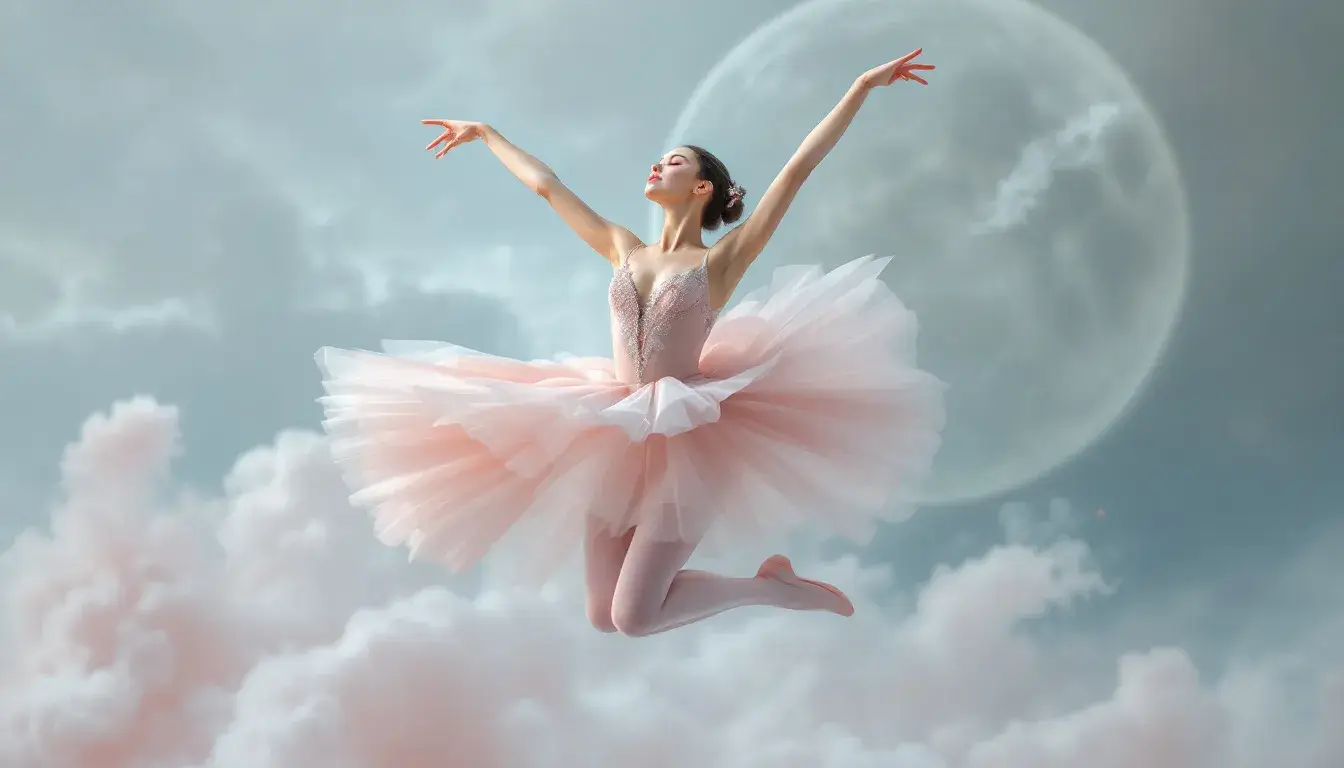
The Romantic era marked a significant shift in ballet, elevating female dancers to central performance roles. Marie Taglioni epitomized this transformation, becoming the quintessential Romantic ballerina with her graceful and ethereal style. Her mastery of pointe work, which became significant during the 1840s, allowed her to perform with an otherworldly lightness, enhancing her roles’ romantic view and mystical quality.
Pointe shoes played a crucial role in this evolution, enabling ballerinas to dance on the tips of their toes and create the illusion of weightlessness. The romantic tutu, made from layers of tulle, became the iconic costume for ballerinas, symbolizing Romantic ballet’s ethereal and supernatural aspects.
The ‘ballet blanc’ tradition also played a significant role in elevating young women to the status of ballerinas, showcasing their technical prowess and ethereal beauty. This costume, along with soft, rounded arm movements and a forward-leaning upper body, defined the movement style of Romantic ballerinas.
The narratives of many Romantic ballets centered around spirit women, including sylphs and ghosts, captivating the fascination of male characters. Carlotta Grisi’s portrayal of Giselle exemplified this trend, with her emotional depth and ethereal presence contributing to the character’s enduring legacy.
The popularity of the Romantic ballerina model influenced the portrayal of female dancers in later ballets, establishing the ideal of the delicate and ethereal ballerina. The rise of the ballerina during the Romantic era transformed ballet performances and elevated female dancers’ status within the art form. Their talent and artistry set new standards for ballet, inspiring future generations of dancers and choreographers.
Evolution of Ballet Technique
The Romantic era brought significant advancements in ballet technique, particularly with the refinement of dancing en pointe. This technique, which involves performing on the tips of the toes, was further developed during this period, enhancing the illusion of weightlessness and ethereal grace.
The transition from demi-pointe to full pointe allowed dancers to achieve greater height and lightness in their movements, becoming a hallmark of Romantic ballet. The ‘ballet blanc’ tradition also emerged during this time, significantly influencing the development of pointe work and emphasizing the ethereal qualities of the dancers.
The introduction of the pointe shoe was a pivotal moment in ballet history, fundamentally altering the aesthetic and technical standards of the art form. These shoes enabled dancers to perform with unprecedented precision and elegance, transforming the portrayal of supernatural figures in ballets. Pointe work became a legacy of the Romantic period, influencing ballet technique and performance standards for generations to come.
The romantic tutu evolved into the classical tutu by the late 19th century, allowing for increased visibility of advanced ballet techniques. This transition marked a new era in ballet, where technical proficiency and dynamic performances became central to the art form.
Design and Scenography in Romantic Ballet
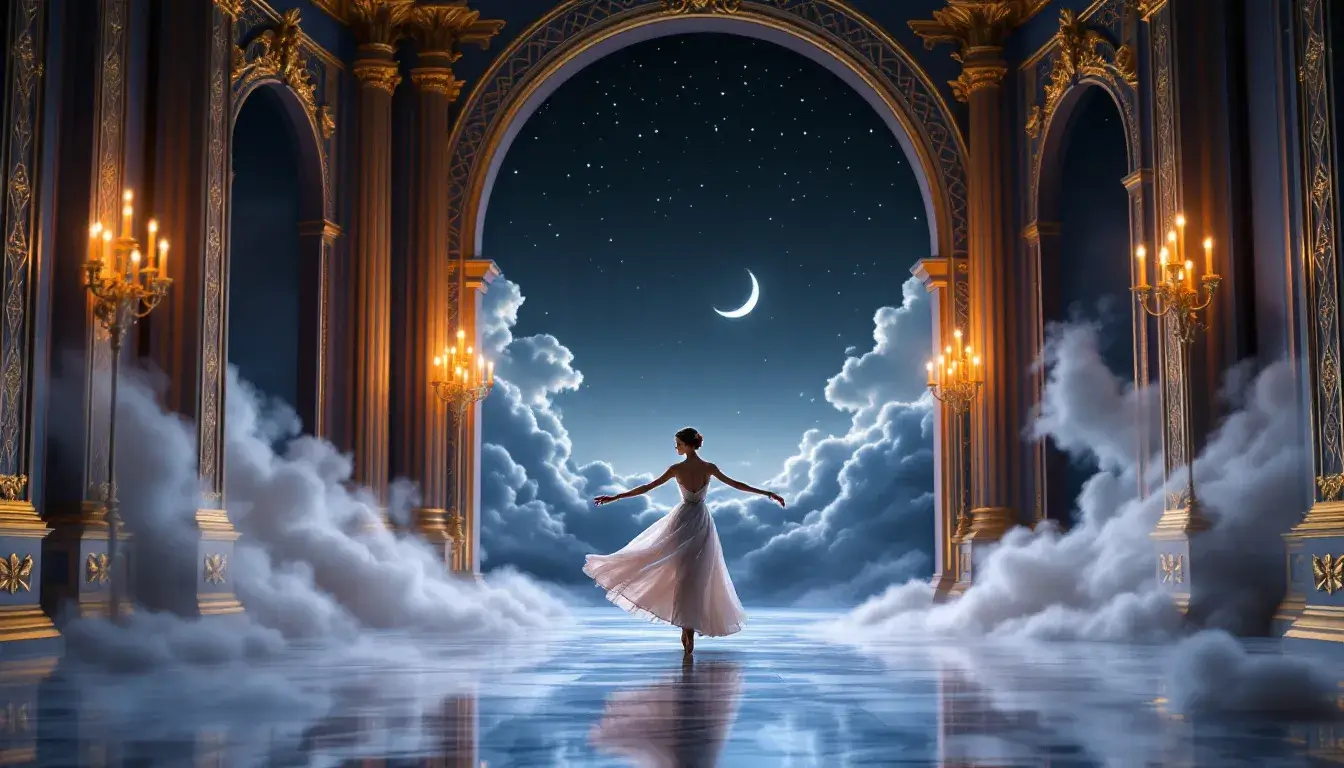
Design and scenography played crucial roles in creating the enchanting atmosphere of Romantic ballet. The romantic tutu, made of layered tulle, became the iconic costume for ballerinas, facilitating a mystical aesthetic that complemented the ethereal themes of the performances.
In Act II of Giselle, the airy white tulle skirts worn by the wilis enhanced their ghostly and supernatural presence on stage. The ‘ballet blanc’ tradition, characterized by the use of white costumes and ethereal designs, was significant in shaping Romantic ballets’ visual and aesthetic elements.
The term “white act” refers to the second acts of many Romantic ballets where the corps de ballet wore romantic tutus, emphasizing themes of spirituality and otherworldliness. These design elements were instrumental in transporting audiences into the fantastical worlds portrayed in the ballets.
The introduction of the bobbinet machine in 1808 revolutionized tulle production, making these romantic costumes more accessible and affordable. This innovation allowed for greater experimentation with costume design, contributing to the aesthetic and emotional impact of Romantic ballet performances.
The Decline and Revival of Romantic Ballet

Various factors, including competition from other art forms and tragic events, influenced Romantic ballet’s decline in the mid-19th century. The sensational debut of singer Jenny Lind in London in 1847 shifted public interest away from ballet, contributing to its decline.
Additionally, the dangers of stage performances were highlighted by incidents like the tragic death of ballerina Emma Livry, whose costume caught fire during a rehearsal.
Despite this decline, new choreographers such as Joseph Mazilier and Arthur Saint-Léon emerged, contributing to the evolution of ballet. The tradition of Romantic ballet continued to survive in various forms, including pantomime, opera, and music halls. The ballet blanc tradition, particularly in Saint Petersburg, showcased the lasting appeal of Romantic themes and ethereal performances.
By the 1890s, a revival of interest in Romantic ballet occurred, with ballet becoming a main attraction at venues like the Alhambra and Empire Theatres in Leicester Square. This revival phase renewed attention to Romantic ballet’s beauty and emotional depth, ensuring its legacy in the ballet world.
The stories of ballerinas like Clara Webster, a young woman whose career ended abruptly due to a stage accident, add to the legacy of Romantic ballet. These narratives highlight the emotional and dramatic nature of the art form, reminding us of its enduring impact on audiences.
Influence on Future Ballets
The influence of Romantic ballet on future works and choreographers is undeniable. Marius Petipa, for instance, incorporated elements from Romantic ballets into his classical pieces, blending romantic themes with classical techniques. His works, such as The Sleeping Beauty, reflect this synthesis, creating timeless masterpieces that continue to captivate audiences.
The ‘ballet blanc’ tradition, characterized by its ethereal and otherworldly aesthetic, also played a crucial role in shaping future ballets, influencing choreographers and productions for generations.
The shift towards original music in ballet, exemplified by Adolphe Adam’s score for Giselle, marked a significant development in the art form. This trend influenced future ballets, encouraging composers to create original scores that enhanced the performances’ narrative and emotional impact.
The revival of Romantic ballet in the 1890s, leading up to productions by Diaghilev, ensured that the themes and techniques of the Romantic era continued to inspire contemporary performances. Works like Sleeping Beauty and The Nutcracker, which blend Romantic and classical elements, showcase the enduring legacy of Romantic ballet in the modern ballet repertoire.
Summary
The Romantic era of ballet, focusing on emotion, dramatic storytelling, and ethereal beauty, has left an indelible mark on the art form and from iconic ballets like La Sylphide and Giselle to the rise of the ballerina and the evolution of ballet technique, this period transformed ballet into a medium of profound artistic expression.
The legacy of Romantic ballet continues to influence and inspire, reminding us of the timeless power of dance to convey emotion and tell captivating stories. Additionally, the ‘ballet blanc’ tradition, characterized by its emphasis on purity and the supernatural, plays a significant role in the legacy of Romantic ballet.
Frequently Asked Questions
What are the defining characteristics of Romantic ballet?
Romantic ballet is defined by its emphasis on emotion and dramatic storytelling, often centering on themes of love, the supernatural, and fantasy. It vividly portrays the conflict between good and evil, creating an ethereal and captivating experience.
Who were some of the key figures in Romantic ballet?
Key figures in Romantic ballet include Marie Taglioni, recognized for her ethereal qualities in “La Sylphide,” and Fanny Elssler, known for her passionate and exotic style, alongside choreographer Jules Perrot, who significantly influenced the period.
What are some of the most famous Romantic ballets?
Some of the most famous Romantic ballets are La Sylphide, which depicts an artist’s longing for the unattainable, and Giselle, which delves into themes of love, madness, and the supernatural.
How did the Romantic era change the role of ballerinas in ballet?
The Romantic era significantly transformed the role of ballerinas by using male dancing, placing them at the forefront of ballet performances, exemplified by stars like Marie Taglioni, and introducing innovations such as pointe work and the romantic tutu. This shift established female dancers as central figures in the art form.
What impact did Romantic ballet have on future ballets?
Romantic ballet significantly shaped future ballets by introducing supernatural themes, innovative music, and advanced techniques, which choreographers like Marius Petipa later integrated into classical works such as The Sleeping Beauty. This blending of styles established a foundation for the evolution of ballet as an art form.
What theater technologies enabled the “weightless” illusions audiences loved during the Romantic era?
Stagecraft jumped forward in the 1830s and ’40s thanks to counterweight fly systems, hidden trapdoors, and rolling panoramas that let sets transform in seconds. Wire rigs suspended dancers so they could “float” or “soar,” while colored silk drops and gauzes added a misty haze. These mechanical tricks and the new gas footlights created the otherworldly atmosphere that became a hallmark of Romantic ballet.
How did gas lighting transform the look and feel of ballet performances?
Gaslights replaced candles and oil lamps, giving theaters a steady, dimmable glow that could spotlight a ballerina or plunge a forest into eerie half‑shadow. For the first time, lighting changes could follow the mood of the choreography in real time, heightening suspense and emphasizing the supernatural themes popular in the 1840s.
Why were wires and harnesses so important for portraying supernatural beings on stage?
Romantic plots teemed with sylphs, wilis, and water nymphs—creatures who seemed to defy gravity. Lightweight harnesses allowed dancers to skim just above the floor or rise and vanish into the flies, convincing 19th‑century audiences that magic was at work. Without these rigs, the ethereal aesthetic central to the era would have been impossible.
In what ways did the Industrial Revolution influence Romantic‑era ballet themes?
Amid factories and urban expansion, spectators longed for nature, folklore, and escape; choreographers obliged with pastoral villages, moonlit forests, and medieval legends. The contrast between gritty city life and onstage fantasy made ballet an especially powerful escapism for newly urban audiences.
What was the public perception of male dancers during this period?
While men choreographed and partnered, star status shifted decisively to women, and some critics mocked male dancers as unnecessary or overly showy. As pointe work stole the spotlight, male roles were often trimmed, leading to a temporary decline in their technical repertoire until the late 19th century revived male virtuosity.
Which Romantic ballets have been lost, and why?
Scores of works—such as “La Gitanilla” and “La Tempête”—exist only in playbills and reviews because choreography was passed down orally. Without film or comprehensive notation, ballets disappeared once they fell out of fashion or when a key dancer retired, leaving historians with only fragments to study today.
How did composers collaborate with choreographers in the 1830s and ’40s?
Unlike the later symphonic scores of Tchaikovsky, Romantic ballet music was often written in modular “numbers.” Composers like Adolphe Adam attended rehearsals, tailoring tempos to specific steps and adjusting orchestration so melodies wouldn’t drown out soft footwork. The process was fast, pragmatic, and dancer‑focused.
What training methods prepared ballerinas for the new demands of full‑length pointe work?
Teachers intensified ankle‑strengthening exercises, practiced balances at the barre with minimal support, and drilled multiple pirouettes en pointe—previously a rarity. Daily class lengthened to two or more hours, and dancers supplemented with calf‑muscle conditioning learned from fencing and gymnastics manuals.
How did Romantic ballet spread beyond Paris to Copenhagen and St. Petersburg?
Touring stars carried repertory abroad—Marie Taglioni to Italy and Russia, Lucile Grahn to Denmark, where local masters restaged works and infused native styles. Imperial theaters, eager to match Parisian prestige, imported designers, musicians, and even gaslighting fixtures, helping Romantic aesthetics take root internationally.
What impact did costume makers have on the evolution of the Romantic tutu?
Innovations in lightweight cotton tulle allowed skirts to hover mid‑calf, short enough to reveal pointe shoes yet long enough to maintain modesty. Dressmakers stiffened the layers with sugar water, giving the tutu a cloud‑like bounce that amplified every jump and turn under the new stage lights.
How were ballerinas marketed in early 19th‑century celebrity culture?
Publishers sold lithographs, scent cards, and even porcelain figurines bearing a star’s likeness. Newspapers chronicled dancers’ diets, rivalries, and rumored romances, turning them into proto‑influencers whose endorsement could sell gloves or perfume across Europe and the United States.
What was the typical structure and length of a full Romantic ballet?
Most works ran two acts, each roughly 45–60 minutes, separated by lavish divertissements—a sequence of character dances that showcased guest artists and local folk styles. This flexible format entertained audiences while scene changes reset elaborate sets behind the curtain.
How did contemporary critics react to the rise of female dominance on stage?
Reviews praised ballerinas’ artistry yet fretted about “feminine excess,” claiming male technique was being sidelined. Some moralists worried that adoration of ballerinas encouraged vanity and frivolity among young women, while others hailed the stage as a rare arena where women could achieve financial independence.
Why did Romantic choreographers incorporate folk dances, and were they authentic?
Folk motifs lent an exotic or pastoral flavor that contrasted with courtly ballet vocabulary, satisfying audience cravings for the “picturesque.” Accuracy varied: choreographers often stylized steps to fit classical lines, so a peasant mazurka or Scottish fling might look refined rather than truly rustic.
How did the waning of Romantic style pave the way for the Classical era in Russia?
As Paris lost interest, the Imperial Theatres of St. Petersburg preserved Romantic technique but demanded bigger ensembles, longer codas, and more virtuosic male solos. This fusion evolved into the grand‑classical spectacles of Marius Petipa, bridging the poetic Romantic ethos with dazzling precision.
What modern efforts exist to reconstruct lost Romantic ballets?
Scholars mine diaries, music scores, and early dance notation systems like Stepanov; companies like the Paris Opera Ballet and reconstruction groups like Les Ballets de l’Opéra de Paris have staged scholarly revivals. Motion‑capture technology and AI‑assisted analysis now help translate historical descriptions into teachable choreography.
How did theater architecture and ticket pricing shape who could attend ballet?
Renovated opera houses introduced raked seating and larger balconies, allowing more affordable “gallery” tickets for the working class while maintaining exclusive boxes for the elite. Variable pricing broadened the audience base, turning ballet into high culture and popular entertainment.
Were there notable dancers of color during the Romantic period?
Documentation is sparse, but archives mention the Cuban‑born dancer Rosetta Mauri, of mixed heritage, who rose to prominence slightly after the Romantic peak. Social barriers and colonial attitudes limited opportunities, yet traveling troupes sometimes featured artists of diverse backgrounds who remain under‑researched today.
